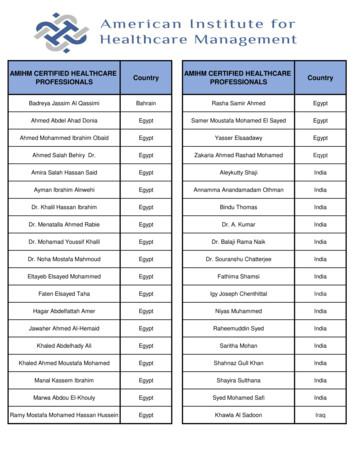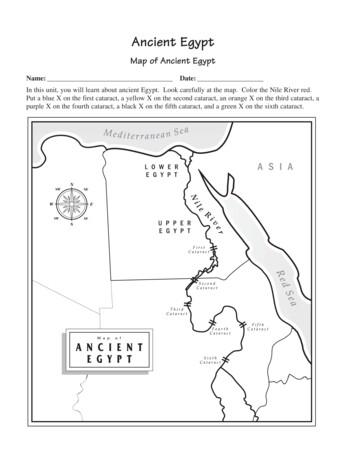Ancient Middle East & Egypt (3200 B.C. – 500 B.C. (pgs. 26 .
Ancient Middle East & Egypt (3200 B.C. – 500 B.C. (pgs.26 – 55)Map orientation: Orientation to the location of the first civilizationsA primary similarity between early civilizations was rivers – why wasthat?We will study early civilizations in:- Mesopotamia (Tigris and Euphrates Rivers)- India (Indus River), and- China (Yellow River)
The Middle East
Ancient Mesopotamia - Timeline
Ancient Middle East & Egypt (3200 B.C. – 500 B.C.(pgs. 26 – 55)Remember the themes: These attributes or characteristicshelp us describe early Civilizations.These will be the themes of our course.- Organized Governments- Complex Religions- Job Specialization- Social Classes- Arts and Architecture- Public Works- Writing- Nomads vs. City Dwellers
Ancient Middle East & Egypt (3200 B.C. – 500 B.C. (pgs.26 – 55)What is a city-state?One of the earliest civilizations inMesopotamia was called Sumer- Sumer was located in the “FertileCrescent” – a strategic location- Sumer was more than one city- Built the first “cities” –monumental architecture, the“ziggurats”
Ancient Middle East & Egypt (3200 B.C. – 500 B.C. (pgs.26 – 55)Besides being some of the first cities with largebuildings, what do we know about Sumer:-Organized GovernmentSocial HierarchyOrganized ReligionWriting system called cuneiformWriting and numbers were important for trade.
Ancient Middle East & Egypt (3200 B.C. – 500 B.C.(pgs. 26 – 55)Even though they were later conquered, the Sumerians left greatachievements for others to build on:-Their most important legacy was probably cuneiform writingThey developed early numbers/mathematics and astronomyTHE WHEEL!!The sail, irrigation and metalworkingWhile art existed previously, cities allowed art to flourish
Ancient Middle East & Egypt (3200 B.C. – 500 B.C.(pgs. 26 – 55) https://www.youtube.com/watch?v sohXPx XZ6Y&list PL4Vw5MJRZ7aNzs72iBKhwOeYxouBamyC1&index 3Crash course video seriesMesopotamia – Write down two items in your notebook from thevideo:One on why being near rivers was importantOne on how religion worked in the social order
Ancient Middle East & Egypt (3200 B.C. – 500 B.C. (pgs.26 – 55)While Sumer was a collection of cities, it did not truly function as anempire – what do you think is the difference between a City-state andan Empire?The first Empire – Akkad was the result of conquering Sumer andbringing all the cities together.There are usually reasons that Empires rise and fall:- Akkad may have been attacked due to drought in neighboring lands- Archeologists believe they built a 100 mile long wall to protectthemselves.
Ancient Middle East & Egypt (3200 B.C. – 500 B.C.)(pgs. 26 – 55)The “Fertile Crescent” was a good place to live and was attacked andconquered many timesBabyloniansHittitesAssyriansPersiansEach built on what the earlier empires had done
Ancient Middle East & Egypt (3200 B.C. – 500 B.C.)(pgs. 26 – 55)The Babylonians – their most famous leader was HammurabiAchievements:The first Law codeIrrigation SystemsTrained ArmyOrganized religion with one primary god
Opening Bell Discussion Do you think nomadic tribeshad laws, even though theymay not have been writtendown? Do laws have to written to beconsidered laws?
Hammurabi and the LawHammurabi’s Law Code:- The oldest complete law code found- Dates back 4000 years- Tells us a lot about how the Babylonians lived
Hammurabi and the LawTo understand what the laws were about we have to “evaluate theevidence”We can read the lawsThese would be considered primary sourcesWhile they tell us some things they are only one source
Hammurabi and the LawHammurabi’s code- Oldest Law Code- Lists 282 laws- Includes all kinds of laws- Needed to have a uniformsystem of laws for theempire- Strengthened the hierarchy- Established punishmentThis is one example of the codewhich is now in a museum
Ancient Middle East & Egypt (3200 B.C. – 500 B.C.)(pgs. 26 – 55)The Hittites:The Hittites conquered the Mesopotamia after the BabyloniansThey were known as fierce fighters with new weapons.- Their Iron weapons were better and cheaper, so helped create astrong army- In time their invention was used by others
Ancient Middle East & Egypt (3200 B.C. – 500 B.C.)(pgs. 26 – 55)The Assyrians:- Originally Nomads- They acquired iron weapon technology- They were very warlike and expanded their empire by conqueringneighboring cities (all the way to Egypt)- They treated the conquered people very harshly and took whateverwealth they could find- Their empire lasted nearly 500 years
The Assyrian Empire
Assyrian ContributionsThough well known for their ability to fight the Assyrians weresophisticated and added knowledge through their empire building:-Well planned cities and large buildingsA library (cuneiform)GlassmakingThe first lock and key
Ancient Middle East & Egypt (3200 B.C. – 500 B.C.)(pgs. 26 – 55)The Babylonians return:- The Assyrians were finally defeated by all the neighboring peoplejoining together- A new Babylonian king emerged – Nebuchadnezzar- Builds the hanging gardens
Ancient Middle East & Egypt (3200 B.C. – 500 B.C.)(pgs. 26 – 55)Nebuchadnezzar and the Babylonians rebuild their empire:- They build great cities with huge defensive walls- Temples to their gods- They advance science, particularly astronomy
Listening with a Purposehttps://www.bing.com/videos/search?q youtube video of the seven ancient wonders of the world&&view detail&mid 5F726B20AACEAA950BC35F726B20AACEAA950BC3&FORM VRDGARThe seven wonders of the ancient world
Ancient Treasure of Nimrudhttps://www.bing.com/videos/search?q youtube ancient treasure of nimrud&view detail&mid E52C0E8072E98769A48CE52C0E8072E98769A48C&FORM VIREVideo
Ancient Middle East & Egypt (3200 B.C. – 500 B.C.)(pgs. 26 – 55)The Persians:- The Persians build an even bigger empire, stretching to India- They allowed conquered people to maintain their religion, andactually took ideas from those they defeated (practiced tolerance)- King Darius is the first great Persian king- He establishes an efficient government to run his large empire- He builds road for trade and communication (including mail)
Ancient Middle East & Egypt (3200 B.C. – 500 B.C.)(pgs. 26 – 55)The Persian Economy:- The Persians use standard weights and measure to improve trade- They encourage the use of coins as money, and Darius mints his owncoinsPersian Religion:- They adopt a single god (monotheism)- Much of their religion resembles later religious beliefs (a “devil” god,a sacred book, judgement day)
Ancient Middle East & Egypt (3200 B.C. – 500 B.C.)(pgs. 26 – 55)And Finally, the Phoenicians:- The Phoenicians were not empire builders- They were sailors and traders They made products to trade such as dye and glass- They did establish many new colonies and cities outside of the MiddleEast- They are also credited with using papyrus paper and inventing whatbecame our alphabet
Ancient Middle East & Egypt (3200 B.C. –500 B.C.) (pgs. 26 –55) The Hittites: The Hittites conquered the Mesopotamia after the Babylonians They were known as fierce fighters with new weapons. - Their Iron weapons we
Ahmed Abdel Ahad Donia Egypt Samer Moustafa Mohamed El Sayed Egypt Ahmed Mohammed Ibrahim Obaid Egypt Yasser Elsaadawy Egypt Ahmed Salah Behiry Dr. Egypt Zakaria Ahmed Rashad Mohamed Eqypt Amira Salah Hassan Said Egypt Aleykutty Shaji India Ayman Ibrahim Alnwehi Egypt Annamma Anandamadam Othman India
This is the third paper in a series of research papers exploring the history of mechanical engineering during the Ancient Egypt era. The industry of necklaces in Ancient Egypt is investigated over seven periods of Ancient Egypt History from Predynastic to Late Period. The paper presents samples of necklaces from the seven periods and tries to .
2.2 Ancient Near East Bard, K.A. (ed.) 1999. Encyclopedia of the archaeology of ancient Egypt. [R 932.003 ENC - articles on various aspects of Ancient Egypt and not only Archaeology] Bienkowski, P. & Millard, A. 2000. Dictionary of the Ancient Near East. London: British Museum Press.
Egypt was a grassland. Nomads traveled in search of food King Menes united Upper & Lower Egypt. Established capital at Memphis. Age of Pyramids. First man made mummies Romans take control of Egypt. Egypt never rises to greatness again. Alexander the Great conquers Egypt. Cleopatra is the last Phar
The first pharaoh of Egypt was Narmer, who united Lower Egypt and Upper Egypt. Egypt was once divided into two kingdoms. The kingdom in Lower Egypt was called the red crown and the one in Upper Egypt was known as the white crown. Around 3100 B.C. Narmer, the pharaoh of the north, conquered the south a
Around 3100 BC, there were two separate kingdoms in Egypt, Upper Egypt and Lower Egypt. Soon aerwards, King Narmer (from Upper Egypt) united the t wo kingdoms. When the unificaon happened, it became the world ’s first ever na†on -state. King Narmer was the first king of Egypt ’s
Ancient Egypt Vocabulary (cont.) 13. Nubia—ancient civilization located to the south of Egypt 14. Old Kingdom—period in ancient Egyptian history from 2686 B.C. to 2181 B.C. 15. papyrus—a plant that was used to make paper 16. pharaoh—ancient Egyptian ruler who was believed to be part god and part human 17. phonogram—a picture that stands for the sound of a letter
ONLINE REGISTRATION: A STEP-BY-STEP GUIDE CONTENTS OVERVIEW 3 HOW TO LOG IN TO ONLINE REGISTRATION 6 PERSONAL DETAILS 7 1. Personal Information (Gender, Marital Status, Mobile Phone No.) 8 2. Social Background (Occupational Background, No. of Dependants). 9 3. Country of Origin/Domicile 9 4. Home Address 10 5. Term Time Address 11 6. Emergency Contact Details 12 7. Disabilities 14 8. Previous .























